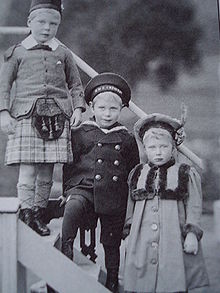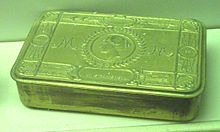- Mary, Princess Royal and Countess of Harewood
-
Princess Mary Princess Royal, Countess of Harewood 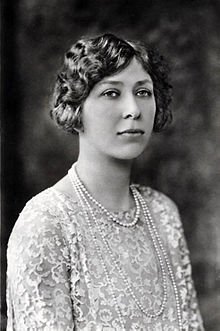
Princess Mary, c. 1926 Spouse Henry Lascelles, 6th Earl of Harewood (1922–1947) Issue George Lascelles, 7th Earl of Harewood
Gerald LascellesFull name Victoria Alexandra Alice Mary House House of Windsor
House of Saxe-Coburg and GothaFather George V of the United Kingdom Mother Mary of Teck Born 25 April 1897
York Cottage, SandringhamDied 28 March 1965 (aged 67)
Harewood House, YorkshireHouse of Windsor 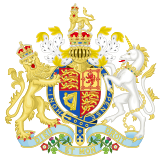
George V Edward VIII George VI Mary, Princess Royal Henry, Duke of Gloucester George, Duke of Kent Prince John Grandchildren Elizabeth II Margaret, Countess of Snowdon Prince William of Gloucester Richard, Duke of Gloucester Edward, Duke of Kent Prince Michael of Kent Princess Alexandra The Princess Mary, Princess Royal and Countess of Harewood (Victoria Alexandra Alice Mary; 25 April 1897 – 28 March 1965) was a member of the British Royal Family; she was the third child and only daughter of King George V and Queen Mary. She was the sixth holder of the title of Princess Royal. Mary held the title of princess with the style Highness from birth as the then great-granddaughter of the British Sovereign, and later Her Royal Highness, as the granddaughter and finally daughter of the Sovereign. After her marriage she held the title of Countess of Harewood.
Contents
Early life
Birth
Princess Mary was born at York Cottage on the Sandringham Estate in Norfolk, England. Her father was Prince George, Duke of York (later George V), the eldest surviving son of The Prince of Wales (later Edward VII) and The Princess of Wales (later Queen Alexandra). Her mother was The Duchess of York (later Queen Mary), the eldest daughter of The Duke and Duchess of Teck.
Mary was named after her paternal great-grandmother, her paternal grandmother, the Princess of Wales, and her maternal grandmother, Princess Mary Adelaide. Since she was born on the same day as her late great aunt, the name Alice was added in. She was always known by the last of her Christian names, Mary. As a great-grandchild of the British monarch (Queen Victoria), she was styled Her Highness Princess Mary of York. In 1898, the Queen passed letters patent granting the children of the Duke and Duchess of York the style, Royal Highness. Mary was then styled Her Royal Highness Princess Mary of York. She was fifth in the line of succession at the time of her birth.
Her baptism took place at in St Mary Magdalene's Church near Sandringham on 7 June 1897 by William Dalrymple Maclagan, Archbishop of York. Her godparents were: Queen Victoria (her great-grandmother); the King of Greece (her granduncle); the Dowager Empress of Russia (her paternal grandaunt); the Prince and Princess of Wales (her paternal grandparents); the Duchess of Teck (her maternal grandmother); Princess Victoria of Wales (her paternal aunt); and Prince Francis of Teck (her maternal uncle).[1]
Education
Princess Mary was educated by governesses, but shared some lessons with her brothers, Prince Edward (later Edward VIII), Prince Albert (later George VI), and Prince Henry (later Duke of Gloucester, whose birth was the first of many that saw her superseded in the line of succession). She became fluent in German and French and developed a life-long interest in horses and horse racing. Her first state appearance was at the coronation of her parents at Westminster Abbey on 11 June 1911.
Royal duties
During World War I, Princess Mary visited hospitals and welfare organizations with her mother, assisting with projects to give comfort to British servicemen and assistance to their families. One of these projects was Princess Mary's Christmas Gift Fund, through which £100,000 worth of gifts was sent to all British soldiers and sailors for Christmas, 1914. This initiative was revived in 2005 by the charity uk4u-Thanks!. She took an active role in promoting the Girl Guide movement, the VADs, and the Land Girls. In 1918, she took a nursing course and went to work at Great Ormond Street Hospital.
Princess Mary's public duties reflected her concerns with nursing, the Girl Guide movement, and the Women's Services.
She became honorary president of the British Girl Guide Association in 1920, a position she held until her death. In 1926, she became the commandant-in-chief of the British Red Cross Detachments.
Marriage and homes
On 28 February 1922, Princess Mary married Henry Charles George, Viscount Lascelles (9 September 1882 – 23 May 1947), the elder son of Henry Lascelles, 5th Earl of Harewood, and Lady Florence Bridgeman of Weston Park. Their wedding at Westminster Abbey was the first royal occasion in which Lady Elizabeth Bowes-Lyon (later Queen Elizabeth), a friend of Princess Mary's and one of the bridesmaids, participated. The Princess was 24, Lord Lascelles was 39. The Princess and her husband had homes in London, Chesterfield House and in Yorkshire, first Goldsborough Hall, and later Harewood House. Whilst at Goldsborough Hall, Princess Mary had internal alterations made by the architect Sydney Kitson, to suit the upbringing of her two children and instigated the development of formal planting of beech-hedge-lined long borders from the south terrace looking for a quarter of a mile down an avenue of lime trees. The limes were planted by her relatives as they visited the Hall throughout the 1920s, including her father George V and her mother Queen Mary. Goldsborough railway station (now disused) was installed in the neighbouring village of Flaxby, along the Harrogate to York line, so that royal guests would have easy passage to the Hall. On 25 March 1923 her first son George was christened at St Mary's Church that adjoins Goldsborough Hall by Cosmo Gordon Lang, Archbishop of York, the service was attended by King George V and Queen Mary. After becoming the Countess of Harewood on the death of her father-in-law, Princess Mary moved to Harewood House and took a keen interest in the interior decoration and renovation of the Lascelles family's seat. In farming pursuits, Princess Mary also became an expert in cattle breeding.
It has been reported that she did not want to marry Lord Lascelles, that her parents forced her into an arranged marriage, and that Lascelles proposed to her after a wager at his club. Her brother the Prince of Wales, later King Edward VIII, with whom she was very close, was against the marriage because he did not want his sister to marry someone whom she did not love. Her elder son, the Earl of Harewood, however, wrote about his parents' marriage in his memoirs The Tongs and the Bones and challenged these widespread rumours that the marriage was an unhappy one. He says "that they got on well together and had a lot of friends and interests in common".
Princess Mary and Lord Lascelles had two sons:
- George Lascelles, 7th Earl of Harewood (7 February 1923 - 11 July 2011); married, 1949, Marion Stein; divorced 1967; married, 1967, Patricia Elizabeth Tuckwell; had issue.
- The Honourable Gerald Lascelles (21 August 1924 – 27 February 1998); married, 1952, Angela Dowding; had issue; divorced 1978; married Elizabeth Collingwood; had issue.
Princess Royal
On 6 October 1929, Lord Lascelles, who had been created a Knight of the Garter upon his marriage, succeeded his father as 6th Earl of Harewood, Viscount Lascelles, and Baron Harewood. The couple's elder son assumed the courtesy title of Viscount Lascelles. On 1 January 1932, George V declared that his only daughter should bear the title Princess Royal, succeeding her aunt Princess Louise, the Princess Royal and Duchess of Fife who'd died a year before as "Princess Royal".
The Princess Royal was particularly close to her eldest brother, the Prince of Wales, who subsequently became Edward VIII (who was known as David to his family). After the abdication crisis, she and her husband went to stay with the former Edward VIII, by then created Duke of Windsor, at Enzenfeld Castle near Vienna. Later, in November 1947, she allegedly declined to attend the wedding of her niece, The Princess Elizabeth, to Lieutenant Philip Mountbatten to protest the fact that the Duke of Windsor had not been invited. She gave ill health as the official reason for her non-attendance.[2] The Duke of Windsor was however invited to the weddings of Princess Margaret and Princess Alexandra of Kent, his nieces, but out of bitterness he refused to attend.
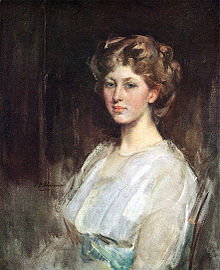 Princess Mary by James Jebusa Shannon
Princess Mary by James Jebusa Shannon
At the outbreak of World War II, the Princess Royal became chief controller and later controller commandant of the Auxiliary Territorial Service (ATS, renamed the Women's Royal Army Corps in 1949). In that capacity she travelled Britain visiting its units, as well as wartime canteens and other welfare organizations. On the death of her younger brother, the Duke of Kent, she became the president of Papworth. The Princess Royal became air chief commandant of Princess Mary's Royal Air Force Nursing Service in 1950 and received the honorary rank of general in the British Army in 1956. Also, in 1949, the 10th Gurkha Rifles were renamed the 10th Princess Mary's Own Gurkha Rifles in her honour.
After her husband's death in 1947, the Princess Royal lived at Harewood House with her elder son and his family. She became the chancellor of the University of Leeds in 1951, and continued to carry out official duties at home and abroad. She attended the coronation of Queen Elizabeth II in June 1953 and later represented the Queen at the independence celebrations of Trinidad and Tobago in 1962, and Zambia in 1964. One of her last official engagements was to represent the Queen at the funeral of Queen Louise (queen consort of Sweden) in early March 1965.
The Princess Royal also made history that same month of March, 1965, when she visited her brother, the Duke of Windsor (formerly King Edward VIII) at the London Clinic, where he was recovering from recent eye surgery. The Princess also met her brother's wife, the Duchess of Windsor (at that time, married to the Duke for more than 28 years), one of the Duchess' few meetings with her husband's immediate family up to that time. A few days later, the Queen also visited the Duke of Windsor, and she accepted the presence of the Duchess, who curtsied to her — the first time that a member of the Royal Family had officially received the Duke's wife.
On 28 March 1965 The Princess Royal suffered a fatal heart attack during a walk with her elder son, Lord Harewood, and his children on the grounds of the Harewood House estate. She was 67 years old. She was buried at Harewood after a private family funeral at York Minster.
Six British monarchs reigned during Princess Mary's lifetime: Queen Victoria (her great-grandmother), Edward VII (her grandfather), George V (her father), Edward VIII and George VI (her brothers) and Elizabeth II (her niece).
Titles, styles, honours and arms
Royal styles of
The Princess Mary
Reference style Her Royal Highness Spoken style Your Royal Highness Alternative style Ma'am Titles and styles
- 25 April 1897 – 28 May 1898[3]: Her Highness Princess Mary of York
- 28 May 1898 – 22 January 1901: Her Royal Highness Princess Mary of York
- 22 January 1901 – 9 November 1901: Her Royal Highness Princess Mary of Cornwall and York
- 9 November 1901 – 6 May 1910: Her Royal Highness Princess Mary of Wales
- 6 May 1910 – 22 February 1922: Her Royal Highness The Princess Mary[4]
- 22 February 1922 – 6 October 1929: Her Royal Highness The Princess Mary, Viscountess Lascelles
- 6 October 1929 – 1 January 1932: Her Royal Highness The Princess Mary, Countess of Harewood
- 1 January 1932 – 28 March 1965: Her Royal Highness The Princess Royal
Born a great-granddaughter of Queen Victoria, Mary was styled Her Highness Princess Mary of York from birth (this was later changed to Her Royal Highness by Queen Victoria). When Queen Victoria died, for a short time she was known as HRH Princess Mary of Cornwall and York (as her father was now the eldest living son of the monarch and thus Duke of Cornwall as well as Duke of York) and then HRH Princess Mary of Wales when her father was created Prince of Wales. Finally, upon her father's accession as King she was styled and titled HRH The Princess Mary. After her marriage, her Harewood titles were affixed after her royal titles. When the title Princess Royal was conferred upon her in 1932, she became known as HRH The Princess Royal (occasionally HRH The Princess Mary, Princess Royal). Throughout her life and the various title changes, her signature was simply "Mary".
Honours
British Honours
- CI: Companion of the Crown of India, 25 April 1919
- GCStJ: Dame Grand Cross of St John of Jerusalem, 12 May 1926
- GBE: Dame Grand Cross of the Order of the British Empire, 3 June 1927
- GCVO: Dame Grand Cross of the Royal Victorian Order, 11 May 1937
- RRC: Member (First Class) of the Royal Red Cross, 1953
- Royal Family Order of King George V
- Royal Family Order of King George VI
- Royal Family Order of Queen Elizabeth II
Foreign Honours
Honorary military appointments
British
- 1918: Colonel-in-Chief, of The Royal Scots (the Royal Regiment)
- 1935: Colonel-in-Chief, of the Royal Signal Corps
- 1947: Colonel-in-Chief, of the West Yorkshire Regiment
- 1958: amalgamated, with the East Yorkshire Regiment (The Duke of York's Own), to form the Prince of Wales' Own Yorkshire Regiment
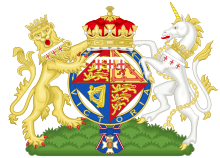 Princess Mary's coat of arms
Princess Mary's coat of arms
Commonwealth
- 1936–1950: Colonel-in-Chief, of the
 Indian Corps of Signals
Indian Corps of Signals - 1937–1965: Colonel-in-Chief, of the Royal
 Australian Corps of Signals
Australian Corps of Signals - 1930–1965: Colonel-in-Chief, of the
 Scottish Regiment (Princess Mary's)
Scottish Regiment (Princess Mary's) - 1940–1965: Colonel-in-Chief, of the Royal
 New Zealand Corps of Signals
New Zealand Corps of Signals - and several other Commonwealth regiments.
Arms
In 1931, Princess Mary, Princess Royal and Countess of Harewood was awarded her own personal arms, being the royal arms, differenced by a label argent of three points, each bearing a cross gules[5]
Ancestry
Notes and sources
- ^ Yvonne's Royalty Home Page — Royal Christenings
- ^ Bradford, Sarah (1989). King George VI. London: Weidenfeld and Nicolson. pp. 424. ISBN 0297796674.
- ^ Royal Styles and Titles – 1898 Letters Patent
- ^ After the accession of her father, George V, she became the child of a Sovereign, and therefore her title changed to The Princess Mary
- ^ Heraldica – British Royal Cadency
Mary, Princess Royal and Countess of HarewoodCadet branch of the House of WettinBorn: 25 April 1897 Died: 28 March 1965British royalty Vacant Title last held byPrincess Louise, Duchess of FifePrincess Royal
1932–1965Vacant Title next held byPrincess AnneAcademic offices Preceded by
The Duke of DevonshireChancellor of the University of Leeds
1951–1965Succeeded by
The Duchess of KentPrincesses Royal Current title holder: HRH The Princess Anne, Princess Royal (since 1987)
Titles granted by reigning monarchs: Mary, Princess of Orange (1642–1660) • Anne, Princess of Orange (1727–1759) • Charlotte, Queen of Württemberg (1766–1828) • Victoria, German Empress (1841–1901) • Princess Louise, Duchess of Fife (1905–1931) • Princess Mary, Countess of Harewood (1932–1965) ·
Title granted by James II in exile: Princess Louisa Maria (1692–1712)
British princesses The generations indicate descent from George I, who formalised the use of the titles prince and princess for members of the British Royal Family. Where a princess may have been or is descended from George I more than once, her most senior descent, by which she bore or bears her title, is used.1st generation 2nd generation 3rd generation - Augusta, Duchess of Brunswick
- Princess Elizabeth
- Princess Louisa
- Caroline Matilda, Queen of Denmark and Norway
4th generation 5th generation 6th generation 7th generation - Louise, Princess Royal and Duchess of Fife
- Princess Victoria
- Maud, Queen of Norway
- Marie, Queen of Romania
- Victoria Melita, Grand Duchess of Hesse
- Alexandra, Princess of Hohenlohe-Langenburg
- Beatrice, Duchess of Galliera
- Margaret, Crown Princess of Sweden
- Patricia of Connaught
- Alice, Countess of Athlone
- Marie Louise, Princess Maximilian of Baden
- Alexandra, Grand Duchess of Mecklenburg-Schwerin
- Olga of Hanover
8th generation - Mary, Princess Royal and Countess of Harewood
- Alexandra, Duchess of Fife
- Maud, Countess of Southesk
- Sibylla, Duchess of Västerbotten
- Caroline Mathilde of Saxe-Coburg and Gotha
- Frederica, Queen of the Hellenes
9th generation - Queen Elizabeth II
- Margaret, Countess of Snowdon
- Alexandra, The Hon Lady Ogilvy
10th generation 11th generation Princesses (by birth) of Saxe-Coburg and Gotha, duchesses in Saxony 1st generation none2nd generation Victoria, Duchess of Nemours · Charlotte, Empress of Mexico*3rd generation Victoria, German Empress** · Alice, Grand Duchess of Hesse and by Rhine** · Helena, Princess Christian of Scheswig-Holstein** · Louise, Duchess of Argyll** · Beatrice, Princess Henry of Battenberg** · Clotilde, Archduchess Joseph Karl of Austria · Amalie, Duchess Maximilian Emanuel in Bavaria · Louise-Marie, Princess of Kohary* · Stéphanie, Crown Princess of Austria* · Henriette, Duchess of Vendôme* · Princess Joséphine-Marie* · Clémentine, Princess Napoléon* · Joséphine-Caroline, Princess Karl Anton of Hohenzollern*4th generation Louise, Duchess of Fife** · Princess Victoria** · Maud, Queen of Norway** · Marie, Queen of Romania** · Victoria Melita, Grand Duchess Cyril Vladimirovich of Russia** · Alexandra, Princess of Hohenlohe-Langenburg** · Beatrice, Duchess of Galliera** · Margaret, Crown Princess of Sweden** · Lady Patricia Ramsay** · Alice, Countess of Athlone** · Dorothea, Duchess of Schleswig-Holstein-Sonderburg-Augustenburg · Marie-José, Queen of Italy*5th generation Mary, Countess of Harewood** · Sibylla, Duchess of Västerbotten** · Caroline Mathilde, Countess of Castell-Rüdenhausen** · Princess Clementine, Mrs. Edward von Heller · Princess Maria Caroline · Theresia, Freifrau von Taxis di Bordogna e Valnigra · Princess Leopoldine · Princess Maria Immaculata · Josephine, Freifrau von Baratta-Dragono6th generation Princess Claudia, Mrs. Gion Schäfer · Beatrice Charlotte, Princess of Saxe-Meiningen7th generation Princess Stephanie · Princess Felicitas Franziska, Mrs. Sergei TrotzkiCategories:- British princesses
- Women of the Victorian era
- People of the Edwardian era
- Princesses Royal
- British nurses
- Companions of the Order of the Crown of India
- Dames Grand Cross of the Order of St John
- Recipients of the Canadian Forces Decoration
- Dames Grand Cross of the Order of the British Empire
- Dames Grand Cross of the Royal Victorian Order
- Girlguiding UK
- House of Windsor
- Members of the Royal Red Cross
- Auxiliary Territorial Service officers
- Women's Royal Army Corps officers
- British Army generals
- 1897 births
- 1965 deaths
- Dames of the Order of Queen Maria Luisa
Wikimedia Foundation. 2010.

